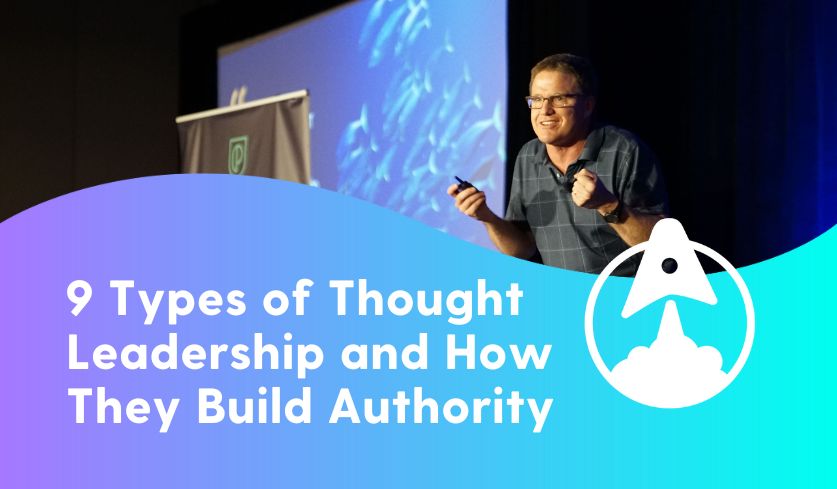No one knows everything, but have you ever known someone who made you doubt that a little? Surely, you know someone you can rely on for accurate answers to any question you ask about a highly specific topic. If so, then you’ve seen thought leadership in action, even if only on a small scale. Large-scale thought leadership is a similar beast, with companies across industries tirelessly working to build authority in their spaces.
Having a reputation as a reliable source of certain information means that customers think of you first when they need to learn about your industry. Your company can build credibility in this way, but it takes a robust strategy to do so effectively. Any good strategy, of course, starts with knowing your options. Below is an in-depth guide on the types of thought leadership content and how to use them to your advantage.
9 common types of thought leadership content
You’ve got a few options for producing thought leadership content. Knowing which types of content you’ll use to represent your company is an excellent starting point for the rest of your marketing strategy. Pro tip: Any type of thought leadership can be effective as long as you offer the reader valuable content — something uniquely insightful or actionable (or both).
1. Opinion articles
In these pieces, you’ll offer an educated opinion about something related to your industry. You’ll often fare best if your opinion goes against industry trends and draws people in with an unexpected but well-supported counter-opinion. See if you can publish this piece on a news website or another company’s blog instead of your own. You can also publish this type of content on LinkedIn.
Look at what’s considered common sense among your peers and really dig in to find a new perspective on an old problem. You might not present the most immediately familiar perspective, but your approach could become the standard over time if you present it compellingly.
2. Case studies
Case studies analyze a customer or client’s situation and detail how you solved their problems. These pieces of content typically live behind gated lead generation forms, so people who want to read them must typically share their contact information first. This way, you can follow up with them afterward. (Be gentle, though! A heavy-handed sales approach can make your thought leadership appear ingenuine.)
In your case study, you should be clear that only you could have achieved the outcomes being presented. This means you should provide clear, empirical results, but don’t be afraid to stretch those creative muscles, either. Telling a story with your data makes reading your content more exciting — and meaningful — to your target audience.
3. Industry analysis
Nothing says “I’m an expert” like pointing out where your competition succeeds and where it could use improvement. You’ll need to relate the analysis back to your company’s views on the industry. News publications, guest blogs, and your own website make great homes for your analyses. You’ll also see this type of analysis on social media sites like LinkedIn.
After reading your industry analysis, anyone interested in your sector will know the pitfalls to avoid and the actions to take for success. And they’ll have you to thank for that.
4. Interviews with other publications
Being an authority in your industry doesn’t necessarily need to mean you have all the answers. It could just mean you share thought-provoking ideas when asked questions in an interview.
For example, if a magazine interviewer asks you what’s next for your field, you can’t know that for certain. You can, though, make a highly educated guess that you back up with your knowledge. This way, you position yourself as an expert in your field while putting the burden of creating thought leadership content on someone else.
5. Data storytelling and visualization
Raw data won’t be as helpful to your readers without supporting context. Creating a narrative and drawing interesting conclusions based on your numbers can draw people in and keep them reading. Alternatively, you can go the visual route and represent the raw numbers on a graph to avoid losing your audience with paragraphs of text. Either way, your own blog is as great a home for this thought leadership content as are news sources and other companies’ blogs.
6. White papers
These lengthy pieces of content are where you’ll leverage your own unique research, data, and expert opinions to come to insightful, one-of-a-kind conclusions. Consistently producing high-quality white papers proves to your readers that you’re serious about improving your industry. Among the people who choose to fill out your lead generation form and obtain your white paper, your extensive reporting builds authority for your company.
7. E-books
When you have a lot to say about an industry-related topic, a simple blog post just isn’t enough. At the same time, you’re probably not looking to write a whole book on the matter — and that’s that’s where e-books enter the picture.
E-books are — you guessed it — digital, so they can be as long or as short as you’d like. Really, the only requirement is that your e-book be longer than a blog post, and it’s typically given to a graphic designer to create a branded, well laid out .pdf file. Provide an e-book rich with unique ideas and insights, and your leads will never forget you.
8. Podcasts
Thought leadership marketing isn’t just for the written word. You can also share your thought leadership through your target audience’s speakers via podcasts. Speaking expert information rather than writing it can help you seem more credible because the listener hears you formulating your ideas in real time.
9. Videos
Take a stroll through YouTube’s archives, and you’ll see some videos, including educational content, getting tons and tons of views. Purely text-based thought leadership isn’t off the table, of course — it’s fundamental to the equation. However, some people might skate past longer articles, so introducing other media matters. Making high-quality videos about relevant subject matter can draw in people who aren’t entirely hooked by blog posts. You can even combine the two, taking the subject of your latest video and turning it into blog content.
8 best practices for all types of thought leadership content
Anyone can write educational content if they have the knowledge to back it up. That said, becoming a thought leader is about more than the information you provide. Thought leadership is also part of your content marketing strategy, which means you should provide information in ways that yield the strongest results. The tips below can help you do exactly that.
1. Offer ideas tailored to your audience, one at a time
Anyone seeing your content in the first place probably has at least some interest in your industry. But they also have their own priorities when it comes to content. Trying to appeal to everyone at once is tricky, and readers can get overwhelmed if you jam your content with as many ideas as possible.
A more reliable idea is to determine your target audience via customer surveys, social listening, and perhaps the practice of developing buyer personas. You should then design your thought leadership strategy around your audience’s interests and pain points.
2. Write and post social media content
Social media gathers people with shared interests, and staying plugged into their communities with intelligent, high-value content can make your brand a household name. Your social posts can engage your audience with your brand, and authentically commenting on platforms like TikTok, Facebook, and LinkedIn shows that your company is part of the community. Plus, sharing others’ thought leadership content on your own social media channels increases the chances that they’ll do the same for you.
3. Analyze the competition
Unless your industry is especially obscure, your company has competitors. At least one of these competitors is currently standing at the top of the pack. Figuring out how it got there lays a clear path for your own thought leadership strategy. Mimic what your strongest competitors are doing well and take any steps you think they’re neglecting. You might find yourself leading your field before you know it.
4. Know your expertise and niche
Don’t go into thought leadership content without a clear idea of what you’re writing about. Namely, ask yourself: What are your specialties? Your company isn’t just an accounting firm — it’s an accounting firm that, for example, primarily serves freelancers. This makes freelance taxation one of your specialties.
As you refine your expertise within your niche, do research, ask questions, and use that information to form unique, resonant opinions. You don’t need to reinvent the wheel, but you do need a clear mission, vision, and brand voice. Combined, these factors establish your authority and show how you tackle your niche from an unparalleled, compelling angle.
5. Leverage the experts you work with
Certain people within your organization will be more qualified to speak on certain topics than others. For example, you probably wouldn’t have your chief financial officer write about the technical aspects of your software. Instead, that might fall to your chief technology officer.
Additionally, many of your team members will bring their own one-of-a-kind backgrounds to the table. Perhaps the lead engineer on your blockchain company’s development team came to your company from working in gaming. See whether their unorthodox background gives them any unexpected yet well-founded viewpoints on your field. If so, ask them to write your content.
6. Consider joint thought leadership content
If another business in your sector shares your ideas on your industry’s future, collaborative thought leadership content can end up helping you both. High-quality thought leadership content that you work together to build can boost both your reputations. For example, your HR organization could team up with a payroll provider to discuss how AI could streamline salary negotiations and ensure accurate payments thereafter. Plus, your new working relationship could lead to business opportunities that your organization might have missed otherwise.
7. Educate, don’t sell
Yes, you’re marketing yourself and your company with thought leadership content, but you’re not trying to persuade your audience to buy anything. Instead, high-value educational content shows the audience that you’re worth engaging with so that they essentially persuade themselves to make a purchase.
Admittedly, this nuanced approach is the core principle underlying all great content writing, but it’s especially important for thought leadership content. You’ll have a much harder time convincing your target audience that you’re an expert worth following if you appear to be interested primarily in sales.
8. Measure and act on your results
Building your thought leadership marketing strategy is a good first step, but it’s not hands-off after the fact. Keep an eye on how your target audience engages with your content, and use this information to adjust your long-term efforts.
For example, look at which of your types of content is performing the best. Is this type of content worth the resources it consumes to achieve its results? Or should you take a less intensive approach that performs ever so slightly less? These big questions are worth asking if you really want to transform a good thought leadership strategy into a great one.
Climb to the top of your industry
Successful thought leadership content makes you one of the most influential voices in your industry and gives you a say in where it goes next. But knowledge and ideas only do you so much good without quality writing to back it up.
Here at The Stellastra Effect, we’ve won leading content marketing awards for how well our content has performed. Our team boasts the skill and versatility to write top-notch thought leadership content no matter the topic put before us. Book a consultation with us today to create content that pushes your brand forward — with your face and name right on it.







